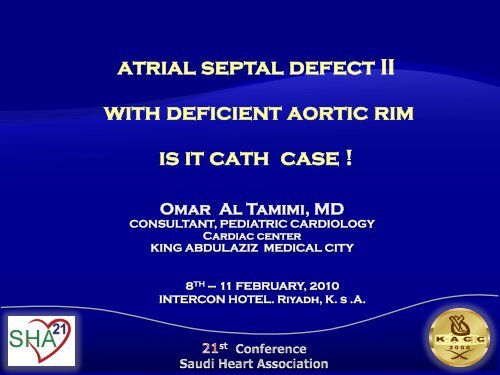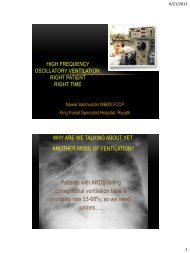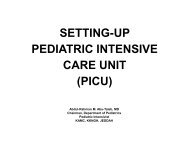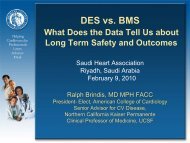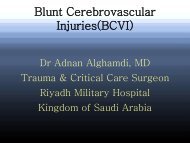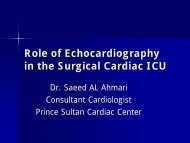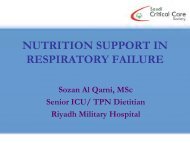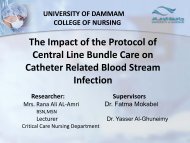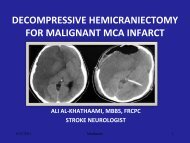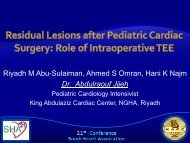atrial septal defect II with deficient aortic rim is it cath case !
atrial septal defect II with deficient aortic rim is it cath case !
atrial septal defect II with deficient aortic rim is it cath case !
Create successful ePaper yourself
Turn your PDF publications into a flip-book with our unique Google optimized e-Paper software.
<strong>atrial</strong> <strong>septal</strong> <strong>defect</strong> <strong>II</strong><br />
<strong>w<strong>it</strong>h</strong> <strong>deficient</strong> <strong>aortic</strong> <strong>rim</strong><br />
<strong>is</strong> <strong>it</strong> <strong>cath</strong> <strong>case</strong> !<br />
Omar Al Tamimi, MD<br />
CONSULTANT, PEDIATRIC CARDIOLOGY<br />
Cardiac center<br />
KING ABDULAZIZ MEDICAL CITY<br />
8 TH – 11 FEBRUARY, 2010<br />
INTERCON HOTEL. Riyadh, K. s .A.
Surgical closure:<br />
Surgical repair <strong>is</strong> the gold standard for<br />
treatment of a secundum type of <strong>atrial</strong> <strong>septal</strong><br />
<strong>defect</strong> (ASD).<br />
Morbid<strong>it</strong>y and mortal<strong>it</strong>y are extremely low,<br />
and long-term follow-up has demonstrated<br />
excellent survival and functional capac<strong>it</strong>y.<br />
Murphy JG et al. Long-term outcome after surgical repair of <strong>is</strong>olated <strong>atrial</strong> <strong>septal</strong> <strong>defect</strong>,<br />
Follow-up at 27 to 32 years. N Engl J Med 1990
ASD <strong>rim</strong>s:<br />
Superior/superior vena cava (SVC) <strong>rim</strong>.<br />
<br />
Superior-posterior/right upper pulmonary<br />
vein <strong>rim</strong>.<br />
Anterior-superior/<strong>aortic</strong> <strong>rim</strong>.<br />
<br />
Inferior/inferior vena cava (IVC) and coronary<br />
sinus <strong>rim</strong>.<br />
Posterior <strong>rim</strong>.
ASD <strong>rim</strong>s:<br />
Butera et al . Am Heart J 2008<br />
Color Atlas of Congen<strong>it</strong>al Heart Surgery<br />
Second Ed<strong>it</strong>ion S. Bert L<strong>it</strong>win, MD
2/3 D image:
2/3 D image:
Technique of device closure <strong>w<strong>it</strong>h</strong><br />
<strong>deficient</strong> <strong>aortic</strong> <strong>rim</strong> :<br />
Hausdorf sheath<br />
Right upper pulmonary vein technique<br />
Left upper pulmonary vein technique<br />
Dilator ass<strong>is</strong>ted technique<br />
Balloon ass<strong>is</strong>ted technique<br />
Right coronary Judkins guide <strong>cath</strong>eter<br />
technique
Device closure:<br />
Recently major advances have been made in<br />
device closure of ASDs.<br />
Reported closure rates have been good, and <strong>it</strong><br />
<strong>is</strong> assumed to have similar morbid<strong>it</strong>y and<br />
mortal<strong>it</strong>y when compared <strong>w<strong>it</strong>h</strong> surgical Repair.<br />
Holzer R, Hijazi ZM. Interventional approach to congen<strong>it</strong>al heart d<strong>is</strong>ease. Curr Opin Cardiol 2004
Device closure:<br />
The presence of a thin or <strong>deficient</strong> <strong>aortic</strong><br />
“<strong>rim</strong>” superiorly has been reported not to<br />
be a contraindication to successful closure,<br />
and in these <strong>case</strong>s the ASO device <strong>is</strong><br />
pos<strong>it</strong>ioned at the base of the aorta<br />
Du ZD, et al. Compar<strong>is</strong>on of Trans<strong>cath</strong>eter closure of secundum <strong>atrial</strong> <strong>septal</strong> <strong>defect</strong> using the Amplatzer<br />
Septal Occluder associated <strong>w<strong>it</strong>h</strong> <strong>deficient</strong> versus sufficient <strong>rim</strong>s. Am J Cardiol 2002
Device closure:<br />
However, most, but not all, secundum ASDs<br />
are amenable to device closure.
Device closure:<br />
However, device closure <strong>is</strong> not <strong>w<strong>it</strong>h</strong>out<br />
complications.<br />
Early and late cardiac perforations are lifethreatening<br />
complications <strong>w<strong>it</strong>h</strong> the incidence<br />
varying from 0.1% to 4%.<br />
Berdat PA, et al. J Thorac Cardiovasc Surg 2000<br />
Preventza O, et al. Ann Thorac Surg 2004<br />
Vojacek J ,et al. Interact CardioVascThorac Surg 2005<br />
2002 US Food and Drug Admin<strong>is</strong>tration. The Amplatzer PFO Occluder<br />
Summary of safety and probable benef<strong>it</strong>.<br />
Divekar A, et. J Am Coll Cardiol 2005
Device closure:<br />
In<strong>it</strong>ial reports of <strong>aortic</strong> wall erosion led to the<br />
recommendation of intentionally over-sizing<br />
the device<br />
The device d<strong>is</strong>ks straddle and remain flared<br />
around the ascending aorta to prevent<br />
d<strong>is</strong>crete areas of pressure where erosion may<br />
occur<br />
Harper Rw ,et al. Closure of secundum <strong>atrial</strong> <strong>septal</strong> <strong>defect</strong>s <strong>w<strong>it</strong>h</strong> the Amplatzer <strong>septal</strong> occluder device:<br />
techniques and problems. Catheter Cardiovasc Interv 2002
Device closure:<br />
MELLO , ET AL .REPAIR OF AORTIC-LEFT<br />
ATRIAL FISTULA Ann Thorac Surg 2005;
Device closure: oversize
Device closure:<br />
MELLO , ET AL .REPAIR OF AORTIC-LEFT ATRIAL<br />
FISTULA Ann Thorac Surg 2005
Lastly the surgeon speak up:
Lastly the surgeon speak up:<br />
Departments of Cardiac Surgery and Cardiology, Children’s<br />
Hosp<strong>it</strong>al Boston, Harvard Medical School, Boston, Mass
July 1, 2002 – june 30 th 2007<br />
223 adverse events in patients undergoing<br />
Amplatzer <strong>atrial</strong> <strong>septal</strong> <strong>defect</strong> closure were<br />
subm<strong>it</strong>ted to the Food and Drug<br />
Admin<strong>is</strong>tration<br />
resulting in 17 deaths (7.6%) and 152 surgical<br />
rescue operations (68.2%).<br />
DiBardino et al The Journal of Thoracic and<br />
Cardiovascular Surgery June 2009
STS data demonstrated 1537 p<strong>rim</strong>ary<br />
operations <strong>w<strong>it</strong>h</strong> 2 deaths (0.13%) and 6<br />
reoperations (0.39%).<br />
Rescue operation for device adverse events<br />
(0.83%) was 2.1 times more likely than<br />
reoperation for surgical closure (0.39%, P = .063).
Mortal<strong>it</strong>y per adverse event was higher for<br />
device closure (7.6%) than for surgical<br />
closure (1.2%, P=.004)<br />
The need for surgery per adverse event was<br />
higher for device closure (68.2%) than for<br />
surgical closure (3.6%, P
The mortal<strong>it</strong>y for surgical management of a<br />
device adverse event (2.6%) was 20-fold higher<br />
than for p<strong>rim</strong>ary elective <strong>atrial</strong> <strong>septal</strong> <strong>defect</strong><br />
closure (0.13%, P
Span<strong>is</strong>h experience:<br />
(Hemodynamics Section) Span<strong>is</strong>h Society of<br />
Cardiology),6345 <strong>case</strong>s of <strong>atrial</strong> <strong>septal</strong> <strong>defect</strong><br />
were closed percutaneously in 2005, <strong>w<strong>it</strong>h</strong> an<br />
incidence of 2.9% for complications and 1.2%<br />
for death.<br />
Marta Ruiz Lera et al.Rev Esp Cardiol. 2007
But we keep arguing:<br />
‘‘the patient <strong>is</strong> only getting the same operation<br />
they would have gotten anyway’’ does not<br />
apply to operations for device complications<br />
DiBardino et al The Journal of Thoracic and<br />
Cardiovascular Surgery June 2009
Finally until we reach a consensus about what<br />
should we do for these <strong>case</strong>s!<br />
Patient should be informed about surgical and<br />
interventional short and long term result of the<br />
procedure <strong>w<strong>it</strong>h</strong> careful follow up if<br />
percutaneous approach preferable.
THANK YOU<br />
Omar Al Tamimi, MD<br />
Cardiac center<br />
KING ABDULAZIZ MEDICAL CITY


